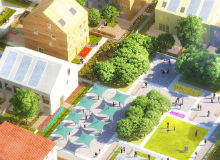

Dutch architectural firm MVRDV and home manufacturer Traumhaus have partnered to “reinvent affordable living in the suburbs”. But is the 27,000m2 project in Mannheim, Germany, just a rehash of the planned communities of the 1920s, or does it offer true innovation? Julian Turner investigates.
